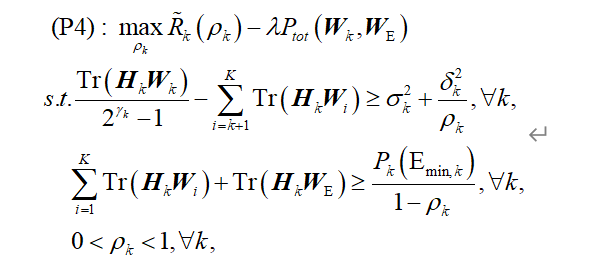
%%%%%%%%%% CVX2 Optimize Power Splitting Factor
cvx_begin sdp quiet
% cvx_precision low
variable rho(K)
variable afa(K)
variable bta(K)
N2 = 0;
for k = 1:K
chnl00 = 0;
for i =1:K
chnl00 = chnl00 + real(trace(H_k(:,:,k)W(:,:,i)));
end
afa(k) >=inv_pos(rho(k));
N2 = N2 +log(chnl00 +sigma + dertaafa(k))/log(2);%%%%%引入松弛变量 %%inv_pos(rho(k)) ;1/(rho(k)/derta);log(chnl00 +sigma + derta*1/(rho(k)))/log(2)
end
D2_pre = 0;
for k = 1:K
chnl11 = 0;
for i = k+1:K
chnl11 = chnl11 + real(trace(H_k(:,:,k)W(:,:,i)));
end
D2_pre = D2_pre +log(chnl11+sigma+derta(1/rho_pre(k)))/log(2);%%%%一阶泰勒展开第一项
end
r_22 = 0;
D2 = 0;
for k = 1:K
r_21 = 0;
for i = k+1:K
r_21=r_21 + real(trace(H_k(:,:,k)W(:,:,i)));
end
r_22 = r_22 +((rho(k)-rho_pre(k))derta)/log(2)((rho_pre(k)^2)(r_21+sigma)+rho_pre(k)*derta);
end
D2 = D2_pre - r_22;
result1 = (N2 - D2)/P_total;
maximize result1
subject to
%%%%%%%%%%%%%R_min Qos Constraint
for k =1:K
r_C1 = 0;
for i =k+1:K
r_C1 = r_C1 + real(trace(H_k(:,:,k)*W(:,:,i)));
end
real(trace(H_k(:,:,k)*W(:,:,k)))/(2^R_min - 1) -r_C1 >= sigma + derta *afa(K);
end
%%%%%%%%%%%%%Energy Qos Constraint
for k = 1:K
r_C2 = 0;
for i =1:K
r_C2 = r_C2 + real(trace(H_k(:,:,k)*W(:,:,i))) ;
end
bta(k)>=inv_pos(1-rho(k));
r_C2 + real(trace(W_E)) >=real(E_NL)*bta(k);
end
for k =1:K
0<=rho(k)<=1;
end
cvx_end
第1轮一阶段第1次
CVX Warning:
Models involving “log” or other functions in the log, exp, and entropy
family are solved using an experimental successive approximation method.
This method is slower and less reliable than the method CVX employs for
other models. Please see the section of the user’s guide entitled
The successive approximation method
for more details about the approach, and for instructions on how to
suppress this warning message in the future.
Successive approximation method to be employed.
For improved efficiency, SDPT3 is solving the dual problem.
SDPT3 will be called several times to refine the solution.
Original size: 45 variables, 18 equality constraints
3 exponentials add 24 variables, 15 equality constraints
Cones | Errors |
Mov/Act | Centering Exp cone Poly cone | Status
--------±--------------------------------±--------
3/ 3 | 6.632e-01 3.337e-02 0.000e+00 | Inaccurate/Solved
3/ 3 | 1.735e-02 2.181e-05 0.000e+00 | Inaccurate/Solved
2/ 3 | 1.077e-03 8.362e-08 0.000e+00 | Inaccurate/Solved
0/ 0 | 0.000e+00 0.000e+00 0.000e+00 | Inaccurate/Solved
0/ 0 | 0.000e+00 0.000e+00 0.000e+00 | Inaccurate/Solved
0/ 0 | 0.000e+00 0.000e+00 0.000e+00 | Inaccurate/Solved
Status: Inaccurate/Solved
Optimal value (cvx_optval): +25.1737
204 cvx_begin sdp quiet